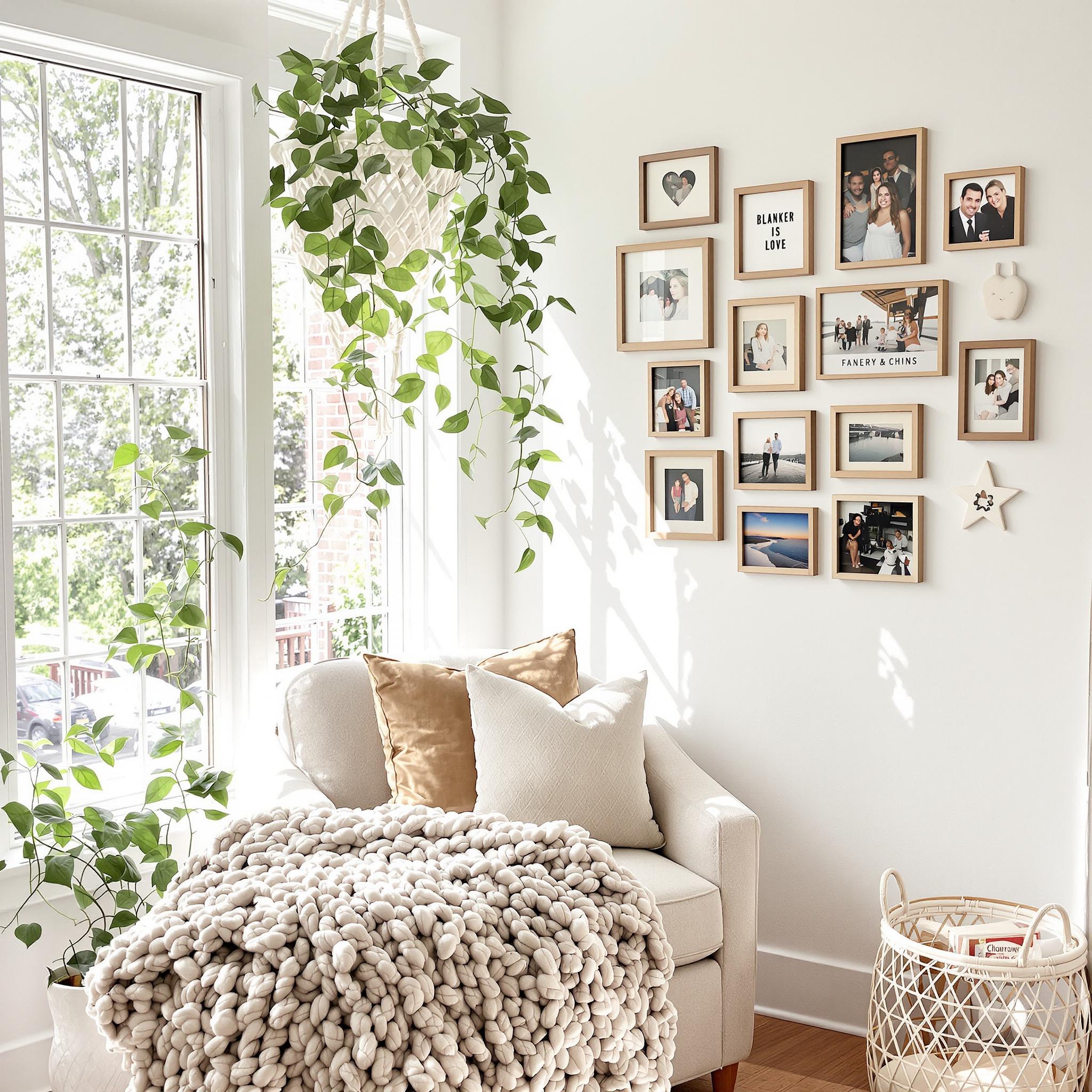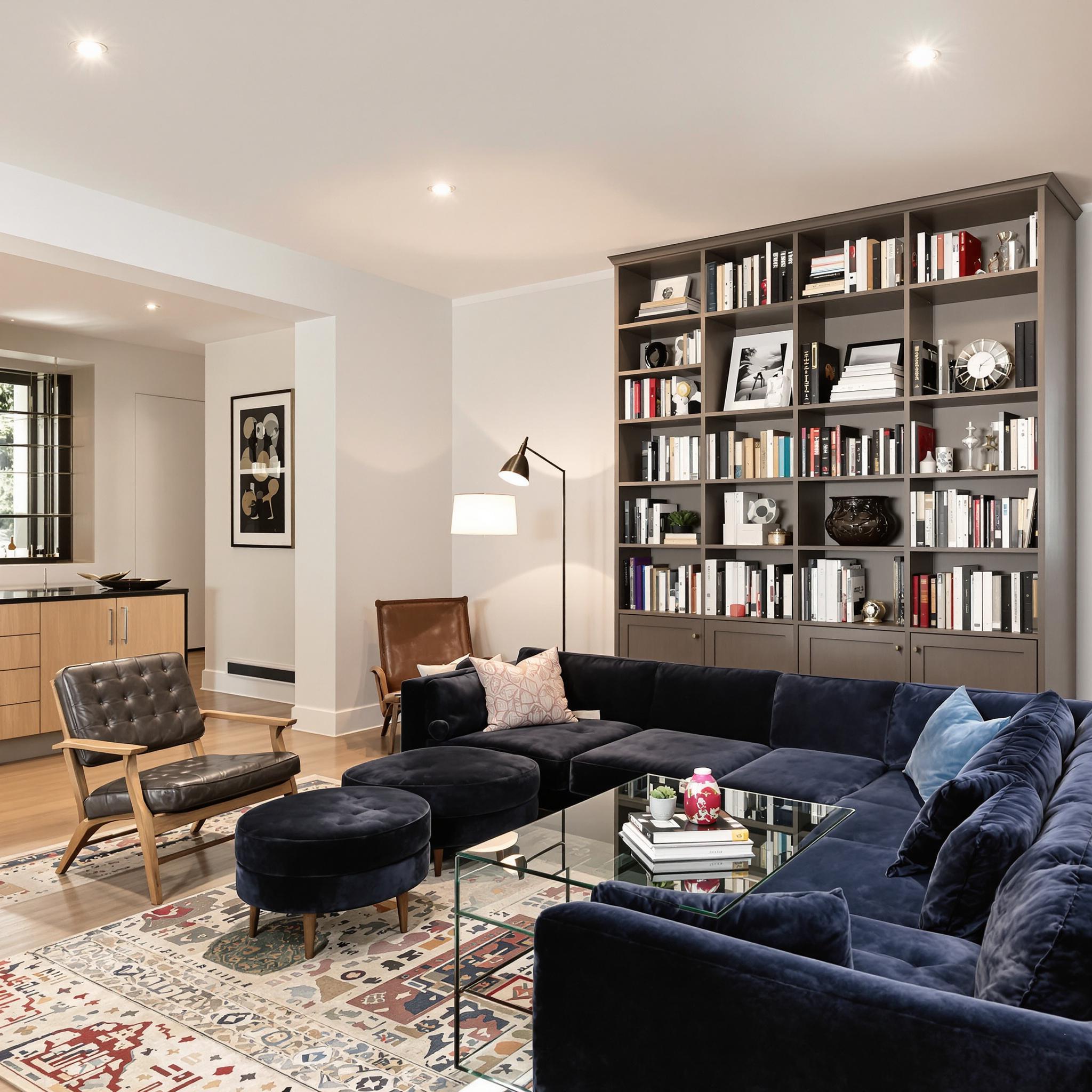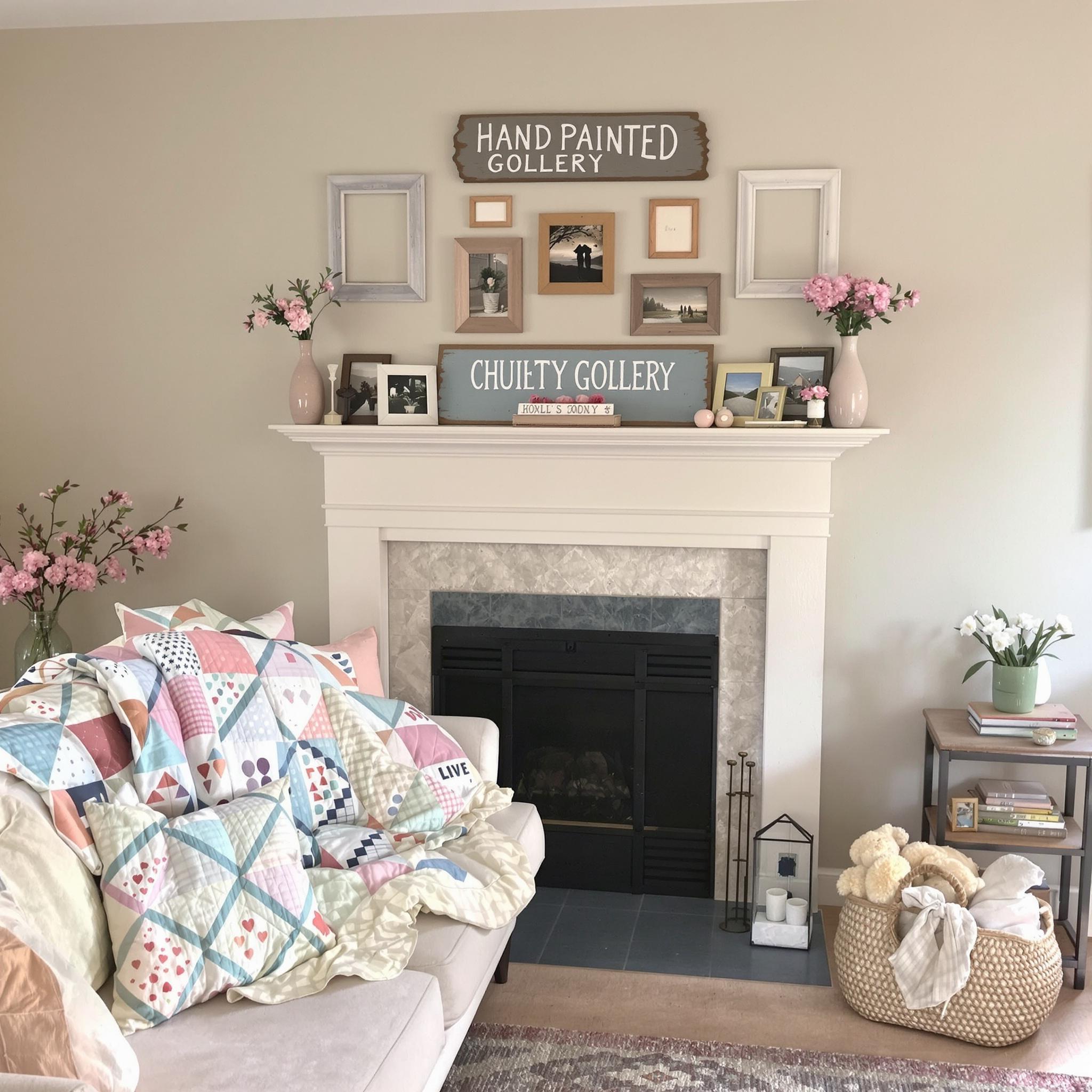What Makes a Living Room ‘Pinterest-Worthy’?
A Pinterest-worthy living room feels inviting, stylish, and personal. It’s not just about trends. It’s about creating a space that works for you.
Start with good lighting. Natural light makes any room feel airy and warm. Add soft lamps or string lights for cozy vibes.
Declutter your space. Too much stuff overwhelms the eye. Keep surfaces clean and organized. Less is more in this case.
Add layers. Mix textures like rugs, throws, and pillows. These small touches make a room feel complete and lived-in.
Greenery matters. Houseplants bring life to a room. They’re also great for air quality. Choose low-maintenance options like pothos or snake plants.
Personalize your decor. Include items that tell your story. A gallery wall of family photos or travel souvenirs adds charm.
Key Elements of Popular Pinterest Design Styles
Pinterest is full of design styles. Here are some favorites and their key features.
- Minimalist: Focuses on simplicity. Neutral colors and clean lines define this look. Think white walls and sleek furniture.
- Boho: Loves bold patterns and earthy tones. Layered rugs, macrame, and plants create a relaxed vibe.
- Modern Farmhouse: Combines rustic and modern elements. Shiplap walls, barn doors, and neutral palettes are staples.
- Scandinavian: Prioritizes function and comfort. Light woods, cozy textiles, and simple shapes shine here.
Each style has its own charm. But they all share one thing: cohesive design. Every piece should feel intentional.
How to Identify Your Personal Style
Finding your style can feel tricky. Start by browsing Pinterest or home decor magazines. Save images that catch your eye.
Notice patterns. Do you love bright colors? Or do you prefer calm neutrals? This helps narrow down your preferences.
Think about how you live. Do you need a space for kids? Or a quiet reading nook? Function matters as much as looks.
Ask yourself: What makes me happy? Decor should reflect your personality. Don’t copy trends just because they’re trendy.
Blend styles if needed. For example, mix boho textures with minimalist furniture. Personal style often combines different influences.
The Role of Color Palettes in Visual Harmony
Color sets the mood of a room. A well-chosen palette ties everything together.
Start with a base color. Whites, grays, or beiges work well. They create a neutral backdrop for bolder accents.
Add pops of color. Use throw pillows, art, or plants. These small touches make a big impact.
Stick to 2-3 main colors. Too many shades can feel chaotic. Limit your palette for a polished look.
Consider undertones. Warm tones feel cozy. Cool tones feel fresh. Match them to your style and needs.
Test colors before committing. Paint swatches on your wall. See how they look at different times of day.
Cohesive Design Principles for a Harmonious Space
Cohesion means every piece works together. It doesn’t mean everything matches perfectly.
Balance is key. Pair large furniture with smaller decor. Avoid overcrowding the room.
Repeat elements throughout the space. Use similar materials or colors. This creates flow.
Vary heights and textures. Mix tall vases with short candles. Combine smooth fabrics with rough ones.
Focus on focal points. Highlight one standout feature, like a fireplace or artwork. Let it anchor the room.
Edit ruthlessly. Remove items that don’t fit. A cohesive space feels calm and intentional.
Blending Trends with Timeless Appeal
Trends come and go. Aim for a mix of trendy and timeless pieces.
Invest in classic furniture. Sofas and tables should last years. Trends can guide smaller decor choices.
Update with accessories. Swap out pillows or curtains when trends change. This keeps your space fresh.
Avoid overdoing one trend. Too much of anything feels dated fast. Balance trendy items with neutral staples.
Trust your instincts. You know what you love. Trends are just inspiration, not rules.
Real-Life Inspiration: A Personal Story
I once decorated my living room without a plan. I bought random pieces I liked. The result? A cluttered mess.
I started over. I picked a style—boho—and stuck to it. I added layers of texture and greenery. The room transformed.
My advice? Start small. Change one thing at a time. See how it feels before moving forward.
Your living room should tell your story. Make it a place you love to be.
Planning Your Layout for Functionality and Flow
Let’s talk layout. A Pinterest-perfect living room isn’t just about tossing furniture in a room. I once rearranged mine five times in one weekend. By the end, I learned something: function beats looks every time. Sure, style matters, but if people are tripping over your ottoman, you’ve got issues.
Start by figuring out what your space is for. Is it for movie nights? Hosting friends? Or both? Once you know, break the room into zones. If space is tight, combine seating with storage. I turned an awkward corner into a reading nook with a small bookshelf and comfy chair. Everyone loves it now.
Don’t forget flow. Make sure there’s enough room to move around. Leave at least 3 feet between big pieces like sofas and chairs. Trust me, you’ll thank yourself later when guests aren’t dodging furniture.
Selecting Statement Furniture Pieces That Anchor the Space
Now the fun part: picking standout furniture. Think of it like casting the lead in a Netflix show—it’s gotta shine. When I designed my living room, I splurged on a bold velvet sectional. It wasn’t cheap, but it sets the tone and gets tons of compliments.
Balance is key. If you go bold with one piece, keep the rest simple. Mixing styles works too. Pair a sleek modern chair with a rustic table. Just make sure they share a color or material to tie it together.
If you’re on a budget, check thrift stores or Facebook Marketplace. My best find was a vintage leather armchair for $40. After some cleaning, it looked amazing. Sometimes those unexpected finds give your space its personality.
Incorporating Textures, Patterns, and Layers to Add Depth
Textures, patterns, and layers make a room feel cozy and lived-in. Imagine a plain beige couch in a white-walled room. Boring, right? Now picture it with chunky knit throws, patterned pillows, and a sheepskin rug. Big difference.
Textures add flavor, like spices in cooking. Mix soft fabrics like velvet with harder materials like wood or metal. In my living room, a rattan basket next to a plush pouf creates contrast. It keeps the eye moving and adds interest.
Patterns can be tricky but also fun. Stick to three max per room, varying their size. For example, pair a large floral print with a medium geometric and a small stripe. Start small if you’re unsure—cushions or curtains are easy to swap out.
Layering rugs is another trick I love. A neutral jute rug under a patterned one instantly warms up the space. Plus, you can change the top layer whenever you want a refresh. Layered rugs might just be my favorite thing.
Styling with Decor Accents Like Rugs, Throw Pillows, Curtains, and Wall Art
Confession: I used to think decor accents were fluff. Then I redecorated last year and realized how powerful they are. Little things like rugs, pillows, curtains, and art can totally transform a space—and they’re easy to update.
Take throw pillows. They’re like jewelry for your living room. Mix shapes, sizes, and textures. I pair square pillows with lumbar ones—it feels intentional but still relaxed. Stick to a color palette so it doesn’t look chaotic.
Curtains frame windows beautifully and soften the vibe. Go floor-length, even if your windows aren’t tall. This trick makes the room feel bigger. I learned it from a designer friend, and it made a huge difference.
Wall art adds personality. Whether it’s a gallery wall or a single piece, it brings life to your space. Don’t stress about perfection—homemade or travel souvenirs work great. Just hang them at eye level. High placements scream amateur.
Maximizing Natural Light and Choosing the Right Lighting Fixtures
Lighting can make or break a room. Who hasn’t walked into a dim space and felt blah? First, maximize natural light. If you have big windows, embrace them. Use sheer curtains and mirrors to bounce light around. My mirror trick saves many gloomy days.
After dark, lighting layers are key. Start with ambient lights—overhead fixtures or chandeliers—for overall mood. Add task lighting like floor or table lamps for specific activities. Finish with accent lights, like string lights or LEDs, for a magical touch.
Funny story: I once bought a cute lamp online that barely lit anything. Lesson learned—check bulb wattage before buying! Smart bulbs are worth considering. You can adjust brightness and color with your phone. Perfect for different vibes.
Tips for Decluttering and Maintaining an Organized Yet Inviting Atmosphere
Finally, let’s talk decluttering. Too much stuff overwhelms a space. The goal is balance—organized but inviting.
Tackle one area at a time. For me, it’s always the coffee table—a magnet for junk. To fix this, I use a stylish tray to corral small items. Everything looks cleaner with designated spots.
Storage solutions save the day. Ottomans with hidden compartments, floating shelves, and decorative baskets hide clutter while keeping essentials handy. Bonus if they double as decor. Edit ruthlessly—if you haven’t used something in six months, ditch it.
Leave room for personal touches. Family photos, travel mementos, or quirky knick-knacks make a house feel like home. Just remember: less is more. Even cozy spaces can feel chaotic if overloaded.
There you have it—tips to create a functional, stylish, and inviting living room. Happy decorating!
Adding Unique, Personalized Touches for That “You” Factor
Let’s be real—nobody wants a living room that looks like it came straight out of a showroom. Sure, those spaces are pretty, but they lack heart. The trick? Adding personal touches that feel like *you*. You don’t need to splurge on fancy art or over-the-top decor. Often, the best pieces are already around you.
Take this as an example: I turned an old family quilt into a wall hanging. It looked amazing and became a conversation starter whenever friends visited. Personalization is about telling your story. Frame your kid’s artwork, show off travel souvenirs, or use fabric from your grandma’s sewing box for pillow covers. These small details make your space feel cozy and meaningful.
Mixing styles works too. A vintage lamp from a flea market can sit next to a modern side table. Trust yourself—if it feels right, it probably is.
DIY Projects and Budget-Friendly Ideas to Elevate Your Space
Now, let’s talk DIY. Nothing makes a house feel like home more than something you’ve made yourself. You don’t need to be a crafting pro. Even small projects can make a big difference. Once, I painted my plain coffee table navy blue. It changed the whole vibe of my living room—for under $20!
Here are some ideas to try:
- Gallery Wall Remix: Use thrift store frames or mismatched ones you already own.
- Fabric Upgrade: Swap boring pillows for bold prints or textures. Bonus if you sew them!
- Plant Power: Grow plants from cuttings. Spider plants and succulents are easy starters.
Pro tip: Lighting matters. Update a lampshade with washi tape or drape string lights around a bookshelf. It’s all about being creative and having fun.
Seasonal Updates Without Starting Over
Changing your decor with the seasons doesn’t mean redoing your whole room. Focus on swapping smaller items like throw blankets, cushions, vases, and rugs. In winter, go for rich colors and velvets. In spring, lighten up with pastels and linens.
Here’s a funny story: Last summer, I refreshed my living room by adding fresh flowers weekly. Sounds simple, but it made a huge difference. Plus, it got me to the farmer’s market more often—not that I minded.
Another trick? Use seasonal scents. Pumpkin spice in fall, citrus in summer. Smell really does affect how a room feels. And don’t forget textiles! Switch heavy curtains for lighter ones to change the mood.
Keeping Your Living Room Functional AND Livable
Looks are great, but functionality matters too. A Pinterest-perfect room isn’t worth much if it’s not practical. Too many people focus on style over comfort. No one cares how cool your sofa looks if it’s uncomfortable.
Plan ahead. Make sure there’s storage for everyday clutter. Baskets, ottomans with hidden compartments, or floating shelves help keep things tidy. Also, think about traffic flow. If walking through your living room feels like an obstacle course, it’s time to rearrange.
Pets and kids change the game. Invest in durable, washable materials. Microfiber sofas may not sound glamorous, but they’re lifesavers for spills. Sticky rollers aren’t just for clothes—they’re great for pet hair too!
Common Mistakes to Avoid When Balancing Aesthetics and Practicality
Confession: I used to cram way too much stuff into my living room. It felt cluttered and unwelcoming. Lesson learned: less is more. Over-accessorizing is a common mistake.
Another issue? Ignoring scale. That giant sectional might look dreamy online, but if it takes over your room, it’s not helping. Same goes for tiny rugs—they should anchor the seating area, not disappear under it. Measure twice, buy once.
And lighting! Don’t rely only on overhead fixtures. Layered lighting—floor lamps, table lamps, sconces—is key. Harsh fluorescents? Not a good look.
Final Thoughts: Making Your Living Room Truly Yours
Your living room should reflect who you are while still being a place where life happens. It doesn’t have to be perfect. Embrace imperfections, celebrate small wins, and enjoy the process. A home isn’t just walls and furniture—it’s where memories happen.
So go ahead, try that DIY project, swap those pillows, or hang that quirky art. Your living room—and your guests—will thank you.
FAQs About Finishing Touches and Maintenance for Long-Term Appeal
1. How often should I update my living room decor?
Refresh small items like cushions every 6-12 months. Big changes, like furniture, can wait 3-5 years.
2. What’s the easiest way to add personality to a neutral room?
Layer in colorful accents like art, rugs, or plants. They’re cheap and easy to swap later.
3. Can I mix different styles successfully?
Yes! Stick to a unifying element, like color or material, to tie everything together.
4. How do I keep my living room kid-friendly without compromising style?
Choose stain-resistant fabrics, rounded furniture edges, and plenty of baskets for toys.
5. Is it worth investing in quality furniture?
Yes. High-quality pieces last longer and often look better, saving money over time.
6. How can I make my living room feel cozier?
Add soft textures like throws and rugs, warm lighting, and arrange seating close together.
7. What’s the best way to display family photos?
Use a mix of frame sizes and styles on a gallery wall or cluster them on a console table.
8. Should I follow trends in home decor?
Trends can inspire, but focus on timeless pieces. Use trendy accents for short-term updates.
9. How do I choose the right rug size?
Your rug should extend at least 6 inches beyond furniture or fully underneath it.
10. What’s the biggest mistake people make in living room design?
Forgetting functionality. Always balance comfort and usability with aesthetics.



